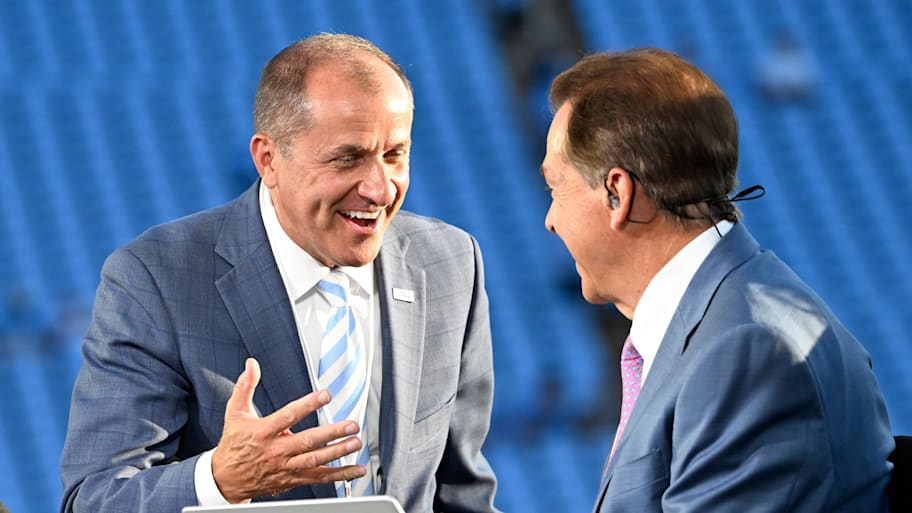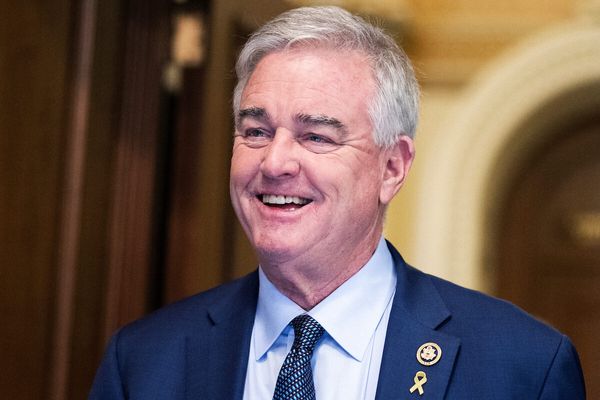

Forty names, games, teams and minutiae making news in college football, where Missouri vs. Kansas added another chapter in rivalry lore—and we’re not just talking about the game. First Quarter: When Your Forever Coach Stops Getting the Job Done. Third Quarter: Can the Big Ten Outspend the SEC? Fourth Quarter: Sixteen Games of Interest.
Second Quarter: The ACC’s Number Crunch
Soon, athletic directors from the Atlantic Coast Conference (11) will meet for a deep discussion on whether to add a ninth league football game for 2026 and beyond. Action may come at that time, or it may not—but at the very least, the ACC should be nearing a consensus on what direction it wants to go in that area. The math is tricky.
With 17 members, it’s not possible for everyone to play nine conventional league games every season—that’s the first issue. No, it’s not likely to result in someone—say, Boston College—being jettisoned to reach a more mathematically friendly 16. But it has left the league looking into a couple of possible alternatives.
Games against non-football ACC member Notre Dame (12) could be applied to league standings. There are currently five or six of those scheduled per season going forward, depending on the year, with the status of the Fighting Irish’s long-standing series with ACC member Stanford still to be determined and an annual matchup with Clemson on the books from 2027 to 2038. That would create some uneven strength of schedule situations, but frankly, those already exist in today’s mega-conference landscape.
Another option is to simply have rotating schedules in which some members play nine games in a year and others play eight. There are a variety of ways to suss out the complications in league standings that would arise from such an arrangement, from simple winning percentage to a weighted schedule evaluation. But it’s not unheard-of for games to be canceled due to weather events, and those have not crippled a conference’s ability to put its teams in rank order. (Also, more leagues—including the ACC—have incorporated analytics among its tiebreaker scenarios; those could theoretically be applied to uneven records as well.)
But this seems to be the bottom-line imperative: commissioner Jim Phillips believes the league must get every member to a minimum of 10 games annually against power-conference teams and/or Notre Dame, and that’s far more easily done with a nine-game ACC schedule than with eight.
This is also a math problem. If the ACC stays at eight, it needs 34 nonconference games against P4 opponents to reach Phillips’s threshold. Nine or 10 are currently baked in annually: the Notre Dame games plus annual rivalries Florida State–Florida, Clemson–South Carolina, Georgia Tech–Georgia and Louisville–Kentucky. It’s hard to find willing partners to schedule 24 more, especially now that the SEC just took away 16 scheduling opportunities by going to a ninth conference game.
So the best solution would appear to be bulking up schedules from within, even if it creates some complications. For a conference that is already struggling to prove its depth (see below), staying at eight games is an invitation to be further marginalized by the rest of the P4.
Conference Call, Part II
Last week, The Dash provided the data on how each FBS league is faring in nonconference games, which will be a major talking point as the College Football Playoff race unfolds. After this past weekend, which was very good for the SEC and very bad for the ACC, here is the updated information. Leagues are in order of winning percentage:
SEC (13)
Overall nonconference record: 27–3.
Record vs. Power 4/Notre Dame: 9–2.
Record vs. rest of FBS: 10–1.
Record vs. FCS: 8–0.
Best win in Week 2: Mississippi State 24, Arizona State 20. The level of pent-up enthusiasm in Starkville, Miss., was starkly obvious in the postgame field rush and taking down of a goal post. (Losing 15 of your last 16 SEC games will leave a mark on the psyche.) Jeff Lebby’s offense has gotten aggressively vertical with Blake Shapen completing five passes of 40 yards or longer through two games. New receivers Brenen Thompson (from Oklahoma) and Anthony Evans III (from Georgia) have combined for 26 catches for 369 yards.
Worst loss in Week 2: South Florida 18, Florida 16. As noted in The Dash First Quarter, this one puts Billy Napier right back in job jeopardy. One touchdown in three red zone trips and a 4-of-12 conversion rate on third down against the Bulls isn’t good enough.
Takeaway: Spitball in The Swamp aside, it was a powerful flex of a weekend for the SEC. Oklahoma joined Mississippi State in announcing themselves as much improved, Missouri got a major rivalry victory and Vanderbilt firmly declared that last season was not a fluke.
Big Ten (14)
Overall record: 31–5.
Record vs. Power 4/Notre Dame: 5–3.
Record vs. rest of FBS: 19–2.
Record vs. FCS: 7–0.
Best win in Week 2: Illinois 45, Duke 19. A plus-5 turnover margin correlates strongly to a blowout, and that was the case in Durham, N.C., as the Illini played a much cleaner game than the Blue Devils. Illinois took the ball away from touted Duke quarterback Darian Mensah three times, once via interception and twice via fumble, and QB Luke Altmyer made a lot of nice plays in a stellar second half. For one of the few times ever, the Illinois-Indiana game on Sept. 20 looms larger.
Worst loss in Week 2: UNLV 30, UCLA 23. Trailing the Rebels 23–0 on the heels of being crushed by Utah is no way to start the season, yet here the Bruins are.
Takeaway: One the one hand, Oregon looked downright scary and Michigan State pulled out a close one. On the other hand, Michigan is still a work in progress offensively and Iowa closely resembles a lost cause on that side of the ball.
Big 12 (15)
Overall record: 25–7.
Record vs. Power 4/Notre Dame: 6–5.
Record vs. rest of FBS: 7–2.
Record vs. FCS: 12–0.
Best win in Week 2: Baylor’s dramatic comeback win at SMU in overtime was a testament to perseverance by the Bears, who had spent seven straight quarters without leading at any point. Sawyer Robertson has been outstanding thus far this season at quarterback.
Worst loss in Week 2: There were some ugly ones to choose from, but Kansas State going down at home to an Army team that lost its opener to Tarleton State was particularly bad. The Wildcats’ defense couldn’t get off the field, and their offense couldn’t sustain drives.
Takeaway: The Big 12 understands the rules of engagement and made its point in the first sentence of its football release Sunday: “The Big 12 is 3–1 versus the ACC with three nonconference games remaining against Power 4 opponents, all of which are ACC programs.” The battle for third-best conference, and the non-automatic playoff bids that may come from that battle, has gone the Big 12’s way so far. But there were also avert-your-eyes performances from Oklahoma State and West Virginia.
ACC
Overall record: 23–11.
Record vs. Power 4/Notre Dame: 4–10 (including NC State–Virginia in a non-league game).
Record vs. rest of FBS: 9–1.
Record vs. FCS: 10–0.
Best win in Week 2: NC State’s victory over the Cavaliers is a zero-sum game for the conference, but it was a second straight dramatic win for the Wolfpack. Delightfully named running back Hollywood Smothers had a big performance, with 140 rushing yards and two touchdowns.
Worst loss in Week 2: Virginia Tech’s home performance against Vanderbilt was the nadir of the Brent Pry era—and that hasn’t been a good era to begin with.
Takeaway: There were shaky wins (Clemson and Syracuse) and tough losses (SMU and Boston College). But Bill Belichick did get his first college victory, laboring past Charlotte. Hopefully the postgame celebration included balloons.
American (16)
Overall record: 16–9.
Record vs. Power 4/Notre Dame: 3–5.
Record vs. rest of FBS: 6–3.
Record vs. FCS: 7–1.
Best win in Week 2: South Florida is carrying the banner for the conference, first by thumping Boise State and now by shocking Florida. The Bulls have run 118 plays this season without a turnover, while taking the ball away four times.
Worst loss in Week 2: UTSA’s home loss in a shootout to Texas State leaves the Roadrunners 0–2 and still searching for a defense. UTSA surrendered 286 passing yards on just 12 completions Saturday, including a 65-yarder for the losing touchdown.
Takeaway: Between South Florida and Tulane, the American has the top two Group of 6 contenders for the CFP. And don’t sleep on either Navy or Memphis.
Mountain West (17)
Overall record: 16–10.
Record vs. Power 4/Notre Dame: 2–7.
Record vs. rest of FBS: 6–3.
Record vs. FCS: 8–0.
Best win in Week 2: UNLV over UCLA. The Rebels are 3–0 under new coach Dan Mullen, improving weekly after a wobbly Week Zero outing against FCS program Idaho State. Virginia transfer Anthony Colandrea has done a nice job running the Vegas offense.
Worst loss in Week 2: San Diego State was pummeled at Washington State, producing just 215 yards of offense and a long run of 13. With two wins over FBS opponents in the last 12 attempts, the Aztecs’ days as a Mountain West power continue to fade.
Takeaway: The league could use a shot of adrenaline. There aren’t a lot of remaining opportunities for statement nonconference wins, but two present themselves this week: Utah at 2–0 Wyoming and New Mexico at 0–2 UCLA.
Sun Belt (18)
Overall record: 13–15.
Record vs. Power 4/Notre Dame: 0–10.
Record vs. rest of FBS: 3–5.
Record vs. FCS: 10–0.
Best win in Week 2: The previously mentioned Texas State road victory over UTSA. Arizona State cannot afford to be wallowing in its loss to Mississippi State when the explosive Bobcats come to Tempe, Ariz., this week.
Worst loss in Week 2: Marshall let Charles Huff go, lost much of its roster to the portal and made an uninspired hire in Tony Gibson. The result is an 0–2 start that includes the home loss Saturday to FBS newcomer Missouri State.
Takeaway: No flags planted yet by Sun Belt teams. Troy’s spirited effort at Clemson was great, but the Trojans self-sabotaged enough to lose a massive upset opportunity. James Madison also played respectably at Louisville.
Conference USA (19)
Overall record: 9–13.
Record vs. Power 4/Notre Dame: 0–8.
Record vs. rest of FBS: 2–4.
Record vs. FCS: 7–1.
Best win in Week 2: Missouri State’s second game as an FBS program was an upset of reigning Sun Belt champion Marshall, with the Bears scoring the final 14 points for a 21–20 road win. That certainly beats the 60-point opening loss to USC.
Worst loss in Week 2: Western Kentucky was blown out at Toledo, trailing 45–7 before scoring two touchdowns in the fourth quarter. The Hilltoppers looked like an outside CFP candidate through their first two games, but not after giving up 508 yards to the Rockets.
Takeaway: With Liberty and WKU already taking a loss, C-USA is probably fresh out of CFP candidates.
Mid-American (20)
Overall record: 7–19.
Record vs. Power 4/Notre Dame: 1–13.
Record vs. rest of FBS: 2–4.
Record vs. FCS: 4–2.
Best win in Week 2: West Virginia made the mistake of scheduling a game at Ohio, and the Bobcats made the Mountaineers pay with a 17–10 upset triumph. Parker Navarro is the full experience at quarterback for Ohio, throwing three interceptions but also producing 334 yards of total offense. Athens, Ohio, must have been wild Saturday night.
Worst loss in Week 2: The MAC had two FCS losses, but the worst of them was Long Island 28, Eastern Michigan 23. It wasn’t as close as the score indicated, with EMU being outgained by 168 yards and tacking on a last-minute touchdown to get within one score. After years of solid competitiveness, this season looks like a regression for the Eagles.
Takeaway: The MAC schedules power-conference teams for the needed pay days, and the results are indicative of the disparity between the top and bottom of FBS. So it’s great to see a MAC school take advantage of the rare visit by a P4 program the way Ohio did.
More College Football on Sports Illustrated
Listen to SI’s new college sports podcast, Others Receiving Votes, below or on Apple and Spotify. Watch the show on SI’s YouTube channel.
This article was originally published on www.si.com as Forde-Yard Dash: Tricky Math Complicates ACC’s Conference Scheduling Future.







